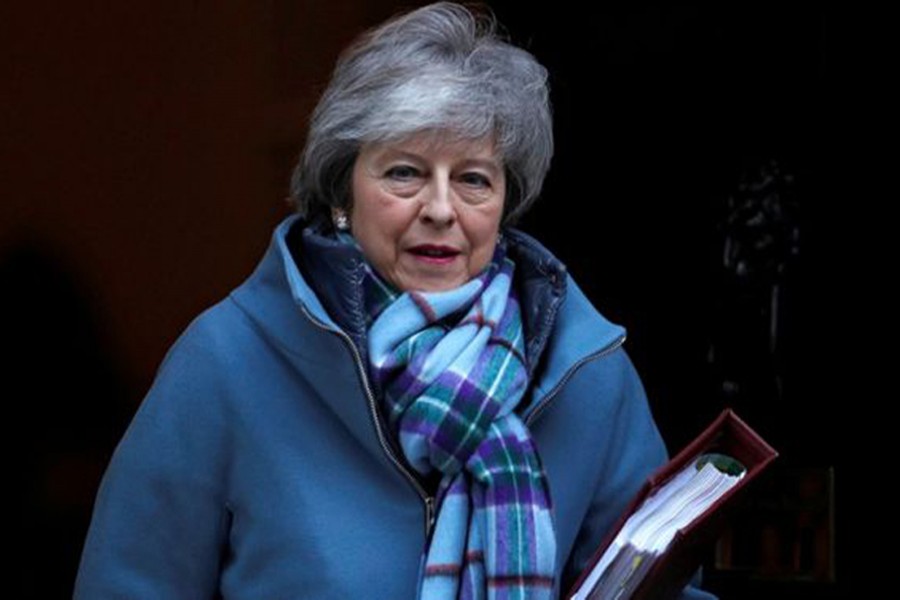Theresa May has said she is "determined" to deliver Brexit on time ahead of talks on the Irish backstop.
Writing in the Sunday Telegraph, the prime minister said she would return to Brussels with a "fresh mandate, new ideas and a renewed determination".
Calls for an "alternative arrangement" for the Northern Ireland border were backed by MPs last Tuesday.
But the Irish deputy prime minister has said "there are no credible alternative arrangements" to the proposal.
Writing in the Sunday Times, Simon Coveney said: "The EU will not renegotiate the withdrawal agreement and there will be no withdrawal agreement without the backstop."
Mr Coveney said the backstop was required to "ensure the protection of the Good Friday Agreement" which ended 30 years of armed struggle in Northern Ireland.
The backstop forms part of the withdrawal agreement negotiated by the UK and EU and is aimed at keeping the border between Northern Ireland and the Irish Republic open after Brexit.
Mrs May said she rejected the suggestion "that seeking alternative arrangements for the backstop constituted 'ripping up the Good Friday Agreement'".
The prime minister added that MPs wanted the government to go back to Brussels to renegotiate the deal after the Commons voted in favour of Tory backbencher Sir Graham Brady's amendment which called for "alternative arrangements" to be found.
What is the backstop?
The backstop is an "insurance policy" - designed to avoid a hard border "under all circumstances" between Northern Ireland and the Irish Republic.
Under the current Brexit deal, the 310-mile Irish border would become the only land border between the EU and the UK.
This would probably mean checks on goods crossing it, unless both sides could reach a comprehensive trade deal.
If such an agreement could not be reached, then to avoid those checks and border posts or other infrastructure, the backstop would come into force.
It would keep the UK in a "single customs territory" with the EU and leave Northern Ireland effectively in the EU's single market for goods.
A number of MPs fear the UK could be "trapped" in this arrangement for years, leaving it unable to strike its own trade deals on goods with the rest of the world.
Writing in the Telegraph, Mrs May wrote: "While replacing the backstop with alternative arrangements was one option, [Sir Graham] would also be happy with the current backstop if there was a time limit or unilateral exit mechanism."
But Mr Coveney said no alternatives have been put forward "that achieve the shared goal of the UK and EU to avoid a hard border", and the backstop was a "necessary guarantee".
Quoting it’s political correspondent Chris Mason, BBC said that while Mrs May pledged to "go back to Brussels to secure a plan that Parliament can stand behind", the EU remains publicly opposed to changing the backstop.
And it added that the UK has not yet publicly suggested an alternative Brussels could live with.
After the Commons voted on the Brady amendment, the EU's chief negotiator Michael Barnier said the backstop is "part and parcel" of the UK's Brexit deal and will not be renegotiated.
In January, MPs rejected Mrs May's withdrawal agreement by 432 votes to 202, with nearly 120 Conservative MPs voting against their leader.
The UK is due to leave the EU at 11:00 GMT on Friday 29 March, when the two-year time limit on withdrawal negotiations enforced by the Article 50 process expires.
Some MPs have suggested Britain will need more time to negotiate its exit to avoid crashing out of the EU without a deal.
Foreign Secretary Jeremy Hunt conceded on Thursday that "extra time" may be needed to get "critical legislation" related to Brexit through Parliament.
But Mrs May has insisted the departure date will not change, writing in the Telegraph that she would "deliver Brexit on time".


